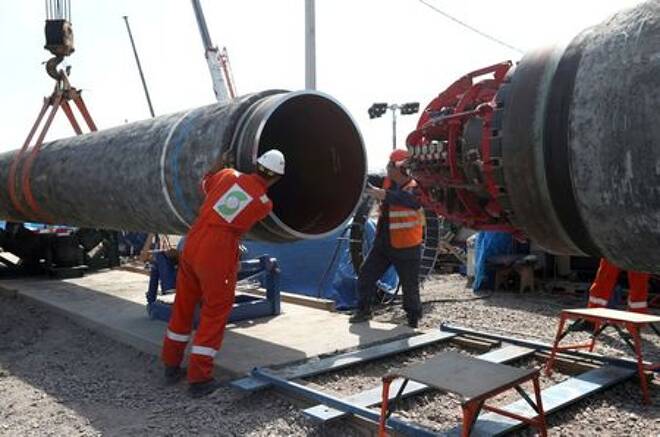Advertisement
Advertisement
Nord Stream 2: Russia’s Push to Boost Gas Supplies to Germany
By:
(Reuters) - The operator of the Nord Stream 2 gas pipeline announced on Monday that the final piece of pipe had been attached, leaving only the linking of its two long stretches to complete the project.
Gas supplier Gazprom will double its export capacity via the Baltic Sea when operations begin, which the project’s operator said it expects by year-end.
Here are some significant moments in Nord Stream 2’s development:
2011
November: Gazprom and Western partners look into expanding the Nord Stream pipeline system by a further 55 billion cubic metres at an initial estimated cost of 9.5 billion euros ($11.3 billion).
2015
June: Gazprom, Royal Dutch Shell, E.ON, OMV, Wintershall and ENGIE agree to build the pipeline.
2016
March: Eight EU governments object on geopolitical grounds.
2017April: Financing agreements are signed.
2018
January: Germany grants permits for construction and operation.
2019
January: The U.S. ambassador to Germany says companies involved in NS 2 could face sanctions.
December: Swiss-Dutch company Allseas suspends pipe-laying.
U.S. President Donald Trump signs a defence policy bill including sanctions.
2020
May: Germany’s energy regulator declines to grant a waiver of EU gas directives to the operators, while an EU court also throws out a challenge to the rules.
Sept. 3: Pressure mounts on Berlin to reconsider support after the alleged nerve agent attack on Kremlin critic Alexei Navalny.
Sept. 23: The world’s largest group of shipping insurers says it will not insure vessels involved in NS 2.
Oct. 1: Denmark gives NS 2 permission to operate in Danish waters.
Dec. 3: The United States unveils a bill targeting companies and individuals helping NS 2.
Dec. 28: NS 2 says it has completed the 2.6 km section in German waters.
2021
Jan 20: Trump on his last full day in office imposes sanctions on Russian pipe-laying ship Fortuna.
German environmental groups file complaints with maritime regulator BSH, effectively preventing further work in Germany for the time being.
Jan. 21: The European parliament passes a resolution calling for a stop to NS 2 completion in response to the arrest of Navalny in Russia.
Jan. 24: Fortuna resumes work in Danish waters.
April 22: The U.S. Senate Foreign Relations Committee advances a bill to pressure companies helping to build NS 2.
May 19: The U.S. State Department waives sanctions around participants of Nord Stream 2, saying it was in the U.S. national interest.
June 4: President Vladimir Putin says Russia has finished laying the first line of the pipeline to Germany.
June 7: U.S. Secretary of State Antony Blinken says completion of Nord Stream 2 is a “fait accompli”, defending the U.S. decision to waive some sanctions and vowing a response if Moscow tries to use gas as a weapon.
June 10: Nord Stream 2 says the project will start preparations to fill the first of two pipelines with natural gas within a few months.
July 22: The United States and Germany announce an agreement on NS 2 under which Berlin also pledged to respond to any attempt by Russia to use energy as a weapon against Ukraine and other Central and Eastern European countries.
July 28: The pipeline operator says NS 2 is 99% complete.
Aug 20: The Biden administration slaps sanctions on a Russian ship and two companies involved in the pipeline.
Putin says there are 15 km (9 miles) left to finish NS 2.
Aug 25: Duesseldorf Higher Regional Court rules that Nord Stream 2 is not exempt from European Union rules that require the owners of pipelines to be different from the suppliers of the gas that flows in them to ensure fair competition.
Sept 6: Russian pipelaying vessel the Fortuna welded the final piece of pipe into place, the project’s operating company said.
For a look at all of today’s economic events, check out our economic calendar.
(Reporting by Tommy Lund and Bartosz Dabrowski in Gdansk; editing by Jason Neely)
About the Author
Reuterscontributor
Reuters, the news and media division of Thomson Reuters, is the world’s largest international multimedia news provider reaching more than one billion people every day. Reuters provides trusted business, financial, national, and international news to professionals via Thomson Reuters desktops, the world's media organizations, and directly to consumers at Reuters.com and via Reuters TV. Learn more about Thomson Reuters products:
Latest news and analysis
Advertisement
